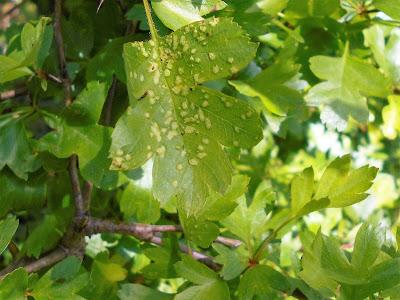The sun was in a genial mood and there was little wind; people were enjoying the conditions in what I judged to be average temperatures for mid April. Insects were abundant, especially bees, but as they are not a group in which I can claim any expertise I spent little time pursuing - or perusing - them. Butterflies were on the wing too, with Common Blue, Polyommatus icarus, Orange -tip, Anthocaris cardamines, and Speckled Wood, Pararge aegeria all present, but only the last-named paused for long enough for a photograph.
 |
Several Speckled Wood butterflies were present. Towcester Road Cemetery,
Northampton. 19 April, 2017
|
It is, in my experience, a particularly approachable insect. This species tends to feed in tree tops, largely on honeydew, but those at ground level appeared to be there for purposes of mating for there was much chasing going on.
Most trees are now approaching full leaf and it hasn't taken long for various creatures to start nibbling, galling or otherwise exploiting this food source. In several places the leaves of hawthorn bore pock-marks caused by the mite Eriophyes crataegi. There are around 50-60 species of Eriophyes to be found in Britain, making them one of the most important of gall-causers.
Most trees are now approaching full leaf and it hasn't taken long for various creatures to start nibbling, galling or otherwise exploiting this food source. In several places the leaves of hawthorn bore pock-marks caused by the mite Eriophyes crataegi. There are around 50-60 species of Eriophyes to be found in Britain, making them one of the most important of gall-causers.
 |
The leaves of hawthorn were pock-marked by galls of the mite,
Eriophyes crataegi.
|
A short distance away elm leaves were showing similar galls and again the culprit was a mite, Aceria campestricola. This is extremely common wherever elms are found, but it seems likely that only the leaves of small-leaved elms are affected and I have never observed it on Wych Elm, Ulmus glabra.
 |
| Elms bore similar tiny gall, but caused by a different mite. |
Elms can be tricky to identify and really are a job for the specialist but Ulmus procera seems to have been the taxon involved here.
We are just entering the bluebell season and there were bluebells a-plenty. Unfortunately all were Spanish Bluebells, Hyacinthoides hispanica. This species is, I feel much superior as a garden plant to our native H. non-scripta but I use the term 'unfortunate' because, as is well-known, in many areas the Spanish Bluebell threatens to 'hybridise out of existence' our own species. As the photograph shows, the flowers of H. hispanica are 'tubbier' and the scape - the flowering stem - is more upright.
We are just entering the bluebell season and there were bluebells a-plenty. Unfortunately all were Spanish Bluebells, Hyacinthoides hispanica. This species is, I feel much superior as a garden plant to our native H. non-scripta but I use the term 'unfortunate' because, as is well-known, in many areas the Spanish Bluebell threatens to 'hybridise out of existence' our own species. As the photograph shows, the flowers of H. hispanica are 'tubbier' and the scape - the flowering stem - is more upright.
 |
| Spanish Bluebells were present but not our native species. |
In the current case, the matter was put beyond doubt by the presence of pink-mauve specimens. Bluebells depend on insects for pollination but today I saw no visitors despite, as I mentioned earlier, the presence of many bees. Speaking of which, the Common Bee-fly, Bombylius major, was frequent, but I suppose its absence would have been more noteworthy.
 |
| Several specimens bore mauve-pink flowers. |
I took no collecting equipment with me; to wield a sweep net would have been indiscreet but fortuitously I did have a small container with me into which I persuaded a few insects for later examination. No rarities were expected of course but one of the beetles collected was a Larch Ladybird, Aphidecta obliterata.
 |
Larch Ladybird. Towcester Road Cemetery, Northampton.
19 April, 2017
|
Not, I'm sure you'll agree, one of the most strikingly coloured of the ladybird family. It is not rare but its rather cryptic coloration against cones or bark makes it easily overlooked.
No comments:
Post a Comment